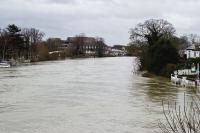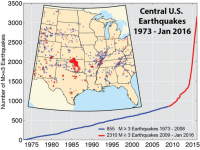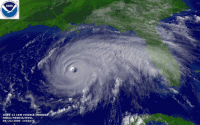-
Climate change already playing major roles
While the effects of future climate change will be significant, the social and economic impacts of our current climate today are often just as severe. A new study looked at current climate impacts on areas such as economy, agriculture, trade, energy, violence, migration, and more. The authors calculate, for example, that high temperatures currently drive up rates of civil conflict in sub-Saharan Africa by 29 percent and slow the growth rate of the global economy by 0.25 percentage points per year.
-
-
Climate change increased chances of record rains in Louisiana by at least 40 percent
Human-caused climate warming increased the chances of the torrential rains that unleashed devastating floods in south Louisiana in mid-August by at least 40 percent, according to a team of NOAA and partner scientists. “We found human-caused, heat-trapping greenhouse gases can play a measurable role in events such as the August rains that resulted in such devastating floods, affecting so many people,” says the lead author of a new study.
-
-
Climate change likely to increase frequency, magnitude of severe U.K. flooding events

Last December, following severe flooding across parts of Northern England and Scotland and on the eve of the climate summit in Paris – which was held 30 November – 12 December 2015 — Lord Deben, chairman of the U.. Committee on Climate Change, said: “Defenses that might historically have provided protection against a 1 in 100 year flood will, with climate change, provide a much lower level of protection and be overtopped more frequently. The latest projections suggest periods of intense rainfall could increase in frequency by a factor of five this century as global temperatures rise.”
-
-
Oklahoma shuts down 37 wells after Saturday’s 5.6 magnitude earthquake

Oklahoma ordered the shutting down of 37 wells after Saturday’s 5.6 magnitude earthquake. Experts note that the significant increase in the number earthquakes measuring 3.0 or higher in Oklahoma has been linked to the practice of underground disposal of wastewater from oil and natural gas production. Only three earthquakes 3.0 magnitude or higher were recorded in 2009. Last year, the state had 907 such quakes. So far this year, there have been more than 400.
-
-
The building evacuation needs of the mobility impaired
A fire alarm sounds. An announcement comes over the office public address system: “A fire has been reported in the building. This is not a drill. Please move to the nearest stairwell and exit the building.” As your colleagues leave their desks, you loosen the wheel locks on your wheelchair and wonder, “Will I be able to get out of the building?” This scenario is among the most common concerns reported in a new study detailing the challenges faced by people with mobility impairments during emergency evacuation from multistory buildings.
-
-
Data shows growing political polarization on climate change
New research discusses the increasing partisan polarization of American attitudes toward climate change. The article details the escalation of partisan polarization, particularly toward environmental protection and climate change, over the past few decades in America, showing an increasing gap between self-identified Republicans’ and Democrats’ attitudes toward human-caused climate change. While Democrats have increasingly accepted the reality and seriousness of climate change over the past two decades, Republicans have become more skeptical.
-
-
Chicago becomes first city to launch Array of Things, an innovative urban sensing project
This week in Chicago, the Array of Things team begins the first phase of the groundbreaking urban sensing project, installing the first of an eventual 500 nodes on city streets. By measuring data on air quality, climate, traffic, and other urban features, these pilot nodes kick off an innovative partnership among different organizations aiming better to understand, serve, and improve cities.
-
-
Assessing climate change vulnerability in urban America
Impacts of climate change – rising sea levels, heat waves, rising rates of diseases caused by ticks, fleas, and mosquitoes, and many more — will affect cities across the country. One of the first efforts systematically to assess how cities are preparing for climate change shows that city planners have yet fully to assess their vulnerability to climate change, leaving serious risks unaddressed. Most city planners have yet to prepare for climate-related risks and the consequences.
-
-
Hurricanes are worse – whether you believe it depends on experience, gender, and politics

Objective measurements of storm intensity show that North Atlantic hurricanes have grown more destructive in recent decades. But coastal residents’ views on the matter depend less on scientific fact and more on their gender, belief in climate change, and recent experience with hurricanes, according to a new study.
-
-
Underground radar locates post-Katrina damage

An innovative underground radar technology is helping a city of in south Louisiana to identify and document underground infrastructure damage that had gone undetected in the months and years following Hurricane Katrina. This radar technology is a pipe-penetrating scanning system based on a new technology called ultra-wide band (UWB) pulsed radar. UWB allows for the inspection of buried pipelines, tunnels, and culverts to detect fractures, quantify corrosion, and determine the presence of voids in the surrounding soil often caused by storm water leaks and flooding.
-
-
Pace of Earth’s warming “unprecedented in 1,000 years”: NASA
The warming of the planet is proceeding at a pace not experienced within the past 1,000 years, making it “very unlikely” to keep warming to 1.5 degrees Celsius – the goal agreed by nations at the Paris climate summit last December. Recent research found that continuing current levels of carbon dioxide emissions for just five more years will eliminate any chance of restraining temperatures to a 1.5C increase and avoid runaway climate change.
-
-
Italy’s deadly earthquake is the latest in a history of destruction
The Appenines region of central Italy has been struck by a deadly earthquake, with a magnitude of 6.2. This earthquake is no surprise. Italy is prone to earthquakes; it sits above the boundary of the African and European plates. The Appenines region’s earthquake history can be traced back over seven centuries. Within the region, there is excellent and continuously improving scientific information about the hazard. But the knowledge of the hazard has not always translated well into measures that directly reduce economic loss and fatalities in earthquakes. Numerous vulnerable buildings remain, and the recovery process is commonly plagued by long disruptions and inadequate government funding to recover rapidly. Both the 2009 L’Aquila earthquake and this most recent quake highlight just how important it is to translate hazard assessments into improving the resilience of infrastructure to strong shaking. The focus should remain on linking science, engineering and policy, this is often the biggest challenge globally.
-
-
Social media helps build a sense of community in the aftermath of disaster
After natural disasters communities rely heavily on local governments to provide the necessary resources and information to respond to such disasters, but these approaches are not well equipped to meeting individual needs. As a complement to traditional methods, social media can provide a more personalized resource as well as fostering a sense of community in response to the crisis.
-
-
Large-scale metamaterials could earthquake-proof buildings in tremor-prone regions
Metamaterials – artificial structures that exhibit extraordinary vibrational properties – could come to the rescue of regions threatened by earthquakes, according to new research. The study, performed by researchers in Europe and involving detailed computer simulations, shows that large-scale metamaterials can attenuate the energy and amplitude of harmful low-frequency vibrations associated with seismic shocks.
-
-
Can we get better at predicting earthquakes?
In the wake of the deadly earthquake, measuring 6.2, which rocked central Italy in the early hours of 24 August, questions again have been raised about whether earthquakes can be predicted. Fortunately, all earthquakes do not lead to disasters and, therefore, understanding where and why disasters are produced is the first goal of earthquake seismology. The first issue is thus one of semantics and objectives. Is the goal to predict an earthquake occurrence, predict ground motion due to an earthquake, or predict a disaster? In our efforts to better predict earthquakes, we have to be precise about the timescale: is it a prediction that an earthquake is imminent – that is, within seconds, hours, or even days before the shaking? Or that it is likely to happen within years or tens of years? There is hope that one day we could detect and monitor extremely slight changes in the rocks that would precede earthquakes – but this is still a long way from “prediction” of precisely when and where a disaster will occur. For now, knowing earthquakes is one way to live with them, to be prepared, to know the vulnerability of our communities and to adopt sound policies for earthquake-safe environments.
-
- All
- Regional
- Water
- Biometrics
- Borders/Immig
- Business
- Cybersecurity
- Detection
- Disasters
- Government
- Infrastructure
- International
- Public health
- Public Safety
- Communication interoperabillity
- Emergency services
- Emergency medical services
- Fire
- First response
- IEDs
- Law Enforcement
- Law Enforcement Technology
- Military technology
- Nonlethal weapons
- Nuclear weapons
- Personal protection equipment
- Police
- Notification /alert systems
- Situational awareness
- Weapons systems
- Sci-Tech
- Sector Reports
- Surveillance
- Transportation
Advertising & Marketing: advertise@newswirepubs.com
Editorial: editor@newswirepubs.com
General: info@newswirepubs.com
2010-2011 © News Wire Publications, LLC News Wire Publications, LLC
220 Old Country Road | Suite 200 | Mineola | New York | 11501
Permissions and Policies
Editorial: editor@newswirepubs.com
General: info@newswirepubs.com
2010-2011 © News Wire Publications, LLC News Wire Publications, LLC
220 Old Country Road | Suite 200 | Mineola | New York | 11501
Permissions and Policies
